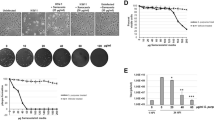Abstract
ANTIBACTERIAL substances have been recovered from bacteria, actinomycetes, fungi, lichens and seed plants1,2 but not from viruses. Gan and Warsa3 observed that the allantoic fluid of embryonated eggs infected with influenza virus possessed lytic activity against a variety of microorganisms, but concluded that this lytic factor was distinct from the virus itself. In the light of the observation that herpes simplex lesions around the nose and mouth rarely, if ever, become infected despite their heavy exposure to pathogenic strains of staphylococci, a study was undertaken to determine whether herpes simplex virus exerts any inhibitory effect on the growth of staphylococci and other bacteria.
This is a preview of subscription content, access via your institution
Access options
Subscribe to this journal
Receive 51 print issues and online access
$199.00 per year
only $3.90 per issue
Buy this article
- Purchase on Springer Link
- Instant access to full article PDF
Prices may be subject to local taxes which are calculated during checkout
Similar content being viewed by others
References
Waksman, S. A., Microbial Antagonisms and Antibiotic Substances (N.Y. Commonwealth Fund, 1945).
Florey, H. W., Chair, E., Heatley, M. A., Jennings, A. G., Sanders, A. G., Abraham, E. P., and Florey, M. E., Antibiotics (Oxford Medical Publications, 1949).
Gan, K. H., and Warsa, R., Amer. J. Hyg., 69, 83 (1959).
Author information
Authors and Affiliations
Rights and permissions
About this article
Cite this article
STANLEY SCHNEIERSON, S., SHORE, B. Antibacterial Activity of Herpes Simplex Virus grown in Tissue Culture. Nature 199, 721–722 (1963). https://doi.org/10.1038/199721a0
Issue Date:
DOI: https://doi.org/10.1038/199721a0
This article is cited by
-
Antibiotic Carry-over in Cell Cultures of Herpes Simplex Virus
Nature (1965)
-
Antibacterial Activity of a Variety of Viruses
Nature (1965)
Comments
By submitting a comment you agree to abide by our Terms and Community Guidelines. If you find something abusive or that does not comply with our terms or guidelines please flag it as inappropriate.



